My very basic electronics education has taught me that parallel circuits are equivalent to separated circuits. To my surprise, when I was playing around with some electronics I found the following:
 Essentially I connected two red and two blue LEDs in parallel. The red ones lit up, but the blue ones didn't. Only when I removed the red LEDs would the blue ones light.
Essentially I connected two red and two blue LEDs in parallel. The red ones lit up, but the blue ones didn't. Only when I removed the red LEDs would the blue ones light.
Why is this?